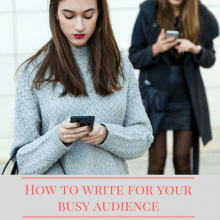How to write for your super-busy audience
By Sandy

Every day inside a Facebook group, I see a version of… “why do people write long posts, no one has time for that!”
Or, “I never read long sales pages. I’m way too busy to read that. Don’t they know they should make them shorter?”
Here’s the thing.
Why not let that something be your thing?
Ok, maybe that’s an unfair assessment. Not every single person on planet earth spends all day on Facebook.
But assuming you’ve already done enough market research to determine that marketing to these peeps online is the best way to reach them? They’re online.
In 2016, a New York Times article reported that users spend an average of 50 minutes per day on Facebook alone.
Around the same time period (2016), Business Insider reported that viewers are spending an average of 2 hours on Netflix… every day!
That’s 3 hours taken out of an average person’s “busy day” to basically do jack poop.
I haven’t even looked into time spent on Instagram, SnapChat, or YouTube (all big players as well). Or just plain old browsing the internet!
So here’s what I’m saying: The problem isn’t how busy they are (nor is it the length of your article).
The problem is how big of a piece of that attention pie you can grab.
But maybe you’re still not satisfied. Maybe you believe that your particular audience would rather read 10,800 ten second posts (say… their Facebook feed) within those 3 hours of entertainment rather than, say, Grapes of Wrath.
Good point.
But when we talk about a long post or a long sales page, how long are we really talking?
The average adult reads between 200-300 words per minute. This speed is also typical of a 6th-grade reader (meaning, the average is fairly low).
High-level executives read closer to 575 words per minute. Successful college students read around 400 words per minute.
So who are you targeting? If your audience reads regularly, they’re probably closer to the 400 word per minute mark.
But let’s play it safe and go with 300 words per minute. This is still pretty “average” for most people.
At that speed, how long would it take your readers to complete your article?
If you’re sticking to 500-word posts, this is about a 1 – 2 minute read.
A long blog post is still only about 1500 words, or, a 5-minute read.
Do those extra 3 minutes really make a huge difference in your reader’s day?
Medium doesn’t think so.
The blog platform offers readers an estimation for how long each article will take someone to read. They also keep track of stats to see how long people actually prefer to read the articles they click on.
Long form articles actually perform better on Medium than very short articles.
This is a great place to evaluate since there is data from so many writers and readers (i.e. they’re better able to test for length across multiple styles and levels of writing).
There are three basic purposes for any form of communication.
Depending on what the purpose of your blog is, you may lean toward one or the other. But if your reader doesn’t feel as though s/he’s getting any of these things, s/he’ll probably click away pretty fast.
But assuming you’re creating interesting content – content that does inform, persuade, entertain, or a combination of the three, there are also other things you can do to entice your readers to engage with your content.
Your reader doesn’t have to read every single line of text to draw enjoyment or value from your post.
And that’s ok.
Don’t fight the scanning, embrace it! Here are some tips to make it more appealing for to scan the article, rather than click away.
Add vidual elements to entice your reader to continue. An article broken up by visually appealing images will propel your reader forward, and keep them from feeling bored.
Next, write like you would speak. Even if you’re in a technical, or professional field.
Too much jargon feels like a day in the office. This is the exact situation your readers are trying to escape from. It’s more effective to use words that create a strong visceral reaction, rather than industry-speak that they only use between the hours of 9-5.
There are lots of places to get information. To appeal to your audience, you’ll want to also provide something extra… either entertainment, a personal connection, a character to follow… something.
A great way to do this is by using stories. It’s ok to mix your personal account with facts and figures. You can be both professional, credible, and personable. It’s all in how you craft your content!
Use these tips, and even the busiest of audiences will find the time to engage with your content. Pinky-promise. 🙂